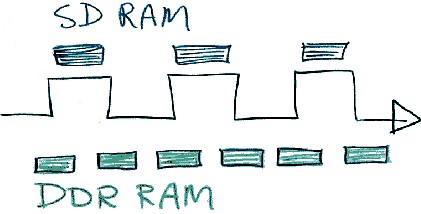It is dynamic random access memory and is used in the PC as it is cheaper than other types of memory because they are less complex to manufacture and stores information using capacitors. Dynamic refers to chip’s need of a constant update signal (also called a refresh signal) to keep the information stored in it and without which the information will be lost. The advantage of DRAM is its structural simplicity so DRAM can reach very high densities. DRAM is volatile memory so it loses its data when power is removed. The components used are extremely small; hundreds of billions can fit on a single memory chip. There are few popular implementations of DRAM: SDRAM, DDR, DDR2, DDR3 and RAMBUS.
SDRAM
Synchronous Dynamic Random Access Memory (SDRAM) is synchronized with the system bus so, its speed is tied to that of the FSB and the processor. Every time the system clock ticks, one bit of data can be transmitted per data pin, limiting the bit rate per pin of SDRAM to that of the clock’s frequency. PC100 refers to a 100MHz clock signal with which memory is synchronized with and with 8 bytes transfer means 800MBps data transfer. SDRAM is slower than the DDR variants, because only one word of data is transmitted per clock cycle (single data rate).
DDR1 SDRAM
Double Data Rate 1 (DDR) SDRAM is the first generation of double data transfer rate against SDRAM by reading and writing data on both the rising and falling of the clock signal. This obtains twice the transfer rate at the same FSB clock frequency. The same 100MHz clock gives a DDR SDRAM system data rate of 1600MBps and the memory module is referred to as PC1600. DDR SDRAM clock rates are 133, 166 and 200 MHz, described as DDR-266, DDR-333 and DDR-400. Corresponding 184-pin DIMM modules are known as PC-2100, PC-2700 and PC-3200.
DDR2
DDR2 SDRAM is very similar to DDR SDRAM, but doubles the read or write to 4 words. This allows the bus rate of the SDRAM to be doubled without increasing the clock rate of internal RAM operations; instead, internal operations are performed in units 4 times as wide as DDR1 SDRAM. Their clock rates are 200, 266, 333 or 400 MHz described as DDR2-400, DDR2-533, DDR2-667 and DDR2-800 and corresponding 240-pin DIMMS are known as PC2-3200 through PC2-6400 giving data rate of 3200MBps to 6400MBps. DDR2 SDRAM is now available at a clock rate of 533 MHz also called DDR2-1066 and the DIMM modules are known as PC2-8500.
DDR3 SDRAM
DDR3 doubles read or write unit to 8 words hence, doubling of bandwidth and bus rate without having to change the clock rate of internal operations, just the width. DDR3 chips clock rates were 400 and 533 MHz, called as DDR3-800 and DDR3-1066 (PC3-6400 and PC3-8500 modules), but 667 and 800 MHz, described as DDR3-1333 and DDR3-1600 (PC3-10600 and PC3-12800 modules) are now common.
DDR4 SDRAM
DDR4 SDRAM will be the successor to DDR3 SDRAM. It was revealed in 2008, and will be released by 2011. The new chips will run at 1.2 V or less, versus the 1.5 V of DDR3 chips, and have in excess of 2 billion data transfers per second. They are expected to be introduced at frequency rates of 2133 MHz, estimated to rise to a potential 4266 MHz and lowered voltage of 1.05 V by 2013.It has a maximum bandwidth of 2.13 Gbps at 1.2 V and draws 40% less power than an equivalent DDR3 module.
| RAM type | Theoretical max. bandwidth |
| SDRAM 100 MHz | 100 MHz X 64 bit= 800 MB/sec |
| DDRAM 200 MHz (PC1600) | 2 X 100 MHz X 64 bit= 1600 MB/sec |
| DDRAM 266 MHz (PC2100) | 2 X 133 MHz X 64 bit= 2128 MB/sec |
| RDRAM 600 MHz | 600 MHz X 16 bit= 1200 MB/sec |

RDRAM
Direct Rambus DRAM or DRDRAM or Rambus DRAM or RDRAM is a type of synchronous dynamic RAM, designed by the Rambus Corporation in 1999 had high cost and is a proprietary standard. RDRAM and DDR SDRAM were involved in a standards war. PC-800 RDRAM, which operated at 400 MHz and delivered 1600 MB/s of bandwidth over a 16-bit bus, was packaged as a 184-pin RIMM (Rambus in-line memory module) form factor, similar to a DIMM (dual in-line memory module). Data is transferred on both the rising and falling edges of the clock signal as in DDR. Even though RDRAM outperformed SDRAM but it was concluded that the performance gain of RDRAM did not justify its premium price over SDRAM except for use in high performance computers thus, RDRAM did not impact the market as hoped.
Apply for IT Support Certification
https://www.vskills.in/certification/certified-it-support-professional

